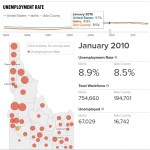Work Prospects Vary Not Just By Generation, But By Graduation Class
Here’s one lesson of the economic downturn: unemployment disadvantages different age groups in different ways.
Yesterday, we revisited the problem of high teen unemployment, which is particularly severe here in Idaho. Labor economists predict the resulting lack of work experience among young people — especially those who can’t afford college or choose not to pursue post-secondary education — could negatively affect earnings years down the road.
Then there’s the predicament of older people who lose jobs. Earlier this spring, a Government Accountability Office report stressed the particular hardship those unemployed workers face. The unemployment rate may be lower among older workers, but when those workers lose jobs they are more likely to face long-term unemployment, the report showed. That, of course, can bring substantial hardship. “Long-term unemployment can put older workers at risk of deferring needed medical care, losing their homes, and accumulating debt,” the GAO report said.
Now, a Bureau of Labor Statistics study explains that even slight variations in age can be predictive of how well or badly workers fared as the recession unfolded. The study compares the employment rate of workers born in 1980-1981 to the employment rate of those born in 1982-1983. The takeaway? “[Y]oung adult men and women who turned 24 or 25 years old just prior to the recent recession experienced more employment losses over the following 18-month period than the older cohort that turned 24 or 25 years old 2 years before the recession,” the report concludes.
In other words: that two-year advantage in the workforce appears to have made a difference. Workers who spent a little more time in the workforce before the recession hit had a better chance of being employed as the recession unfolded.

